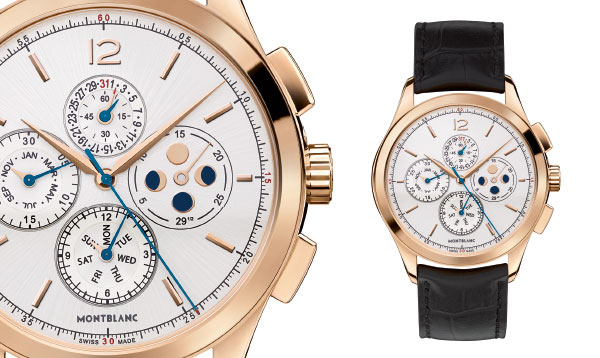
Montblanc Nicolas Rieussec Chronograph Anniversary Edition
Movement : mechanical hand-wound, Calibre MB R110 case : 18K 5N red gold Diameter : 43mm Functions : hours, minutes on the off-centred dial, date on a rotating disc, 72h power reserve, 60-second and 30-minute counters, travel function with fast adjustment of the hour hand and the date case-back : sapphire crystal strap: black alligator leather Water resistance : 30m Limited edition : 25 in platinum, 90 in white gold, 190 in red gold
Horological TimeWriter Nicolas Rieussec
Movement : mechanical hand-wound, Calibre MB R200 Case : 18K red gold Diameter : 43mm Functions : hours, minutes on offset subdial, date, chronograph with 30-minute and 60-second counters, dual timezone and day/night indication case-back : sapphire crystal Strap : brown alligator leather Water resistance: 30m Limited edition : 19 watches
The undeniable special feature of this timepieces is doubtless its incomparable dial characteristic of all Montblanc’s Nicolas Rieussec chronographs. An extremely subtle, pure and classic guilloché motif accentuates the iconic nature of the watch. A subdial at 12 o’clock featuring blued hands and adorned with black or white Breguet numerals displays the ordinary time of day. At 6 o’clock, a V-shaped bridge emerges from the dial and highlights the jewelled bearings for the two rotating chronograph discs : a 60-second counter on the left and a 30-minute counter on the right. Beneath the hour and minute hands turns a finely skeletonised date disc, between the spokes of which can be seen a plate adorned with Geneva waves and the Montblanc emblem. The dial aperture provides a detailed view of the chronograph movement, revealing in particular certain components of the disc coupling.
The interior of this watch is every bit as beautiful as the exterior. The MB R110 calibre deserves special attention. This 263-part movement unites all the major characteristics of the history of the chronograph, including classic function control by means of a column wheel and a modern virtually friction-free vertical coupling clutch that prevents premature wear when the chronograph function is allowed to operate for a lengthy period of time. This hand-wound Manufacture Montblanc movement is equipped with two barrels and a 72-hour power reserve. The remaining running autonomy is displayed on the back of the watch. The sapphire crystal affords an impressive view of not only the column wheel, but also of the balance with adjustment screws which, thanks to its inertia of 12 mg/cm2 and an oscillation frequency of 28,800 vibrations per hour (4 Hz), ensures excellent precision and stable rate.In tribute to the anniversary and to the limited edition, the Montblanc
Nicolas Rieussec anniversary edition is available only in 950 platinum and in red or white 18-carat gold.
Manufacture Montblanc is also commemorating the year 1821 by another exceptional creation in the shape of the Horological TimeWriter Nicolas Rieussec. This prestigious model is a table clock measuring 33 cm high, 33 cm wide and 22 cm deep. It is powered by a movement dedicated to the conventional time indications, along with a chronograph function driven by an independent mechanism, as well as a clock-winder pre-programmed to wind the Nicolas Rieussec automatic wrist chronograph. The three instruments are incorporated within a metal cabinet featuring a vertical satin-brushed finish. It is topped by a glass dome designed to protect the TimeWriter from dust and from other detrimental external influences. The set would not be complete with a Nicolas Rieussec Automatic Limited Edition chronograph in 18-carat red gold. Composed of a table clock, a wrist chronograph and a watch winder, this exceptional creation will be issued in a strictly limited edition of 19.
Since the brand’s core skills lie in making wristwatches, Montblanc naturally wished to cooperate with an exceptional partner in this project. The brand found in the Erwin Sattler clock manufacturer an ideal partner for this type of timepiece. The Horological TimeWriter Nicolas Rieussec by Montblanc thus enshrines a unique three-part homage.
Almost two centuries after Nicolas Rieussec invented the chronograph, Manufacture Montblanc is doing its utmost to celebrate its rich heritage in due style. In cooperation with Musée international d’horlogerie (MIH) in La Chaux-de-Fonds is staging a special exhibition entitled “Writing Time – Two Centuries of Chronograph History”, which retraces the development of this horological complication patented in 1821 by Nicolas Rieussec and describing a timepiece with two rotating discs on which elapsed times were marked using ink-filled, nib-like pointers.
Inaugurated in April by Jean-Michel Piguet, associate curator of the Musée international d’horlogerie and Lutz Bethge, President of the Foundation Minerva de Recherche en Haute Horlogerie and CEO of Montblanc International, this exhibition is due to run until October 2011. Integrated within the museum itself, this temporary exhibition offers visitors three complementary approaches to the chronograph: a central monolith around which the story of the chronograph and its evolution, is told, illustrated by its iconic models and its key milestones, such as the founding 1821 invention by Nicolas Rieussec. This chronology is backed up by a number of displays presenting the technical and creative developments of watches, movements and dials spanning over 200 years of horological history, ranging from 19th century historical pieces through to the astonishing innovations presented in recent years. Finally, the multiple uses and advancements of the chronograph are illustrated on large banners : from horse races to state-of-the-art scientific and industrial developments, along with aviation and the luxury world. To further enrich their knowledge, visitors can interact with a chronograph movement animation explaining the stop/start functions and relating to the heart of contemporary chronographs – all of which pursue the objective of “writing time” by recording an elapsed period of time.
Entrance to the museum includes access to the exhibition which is open to all visitors during the museum’s opening times, meaning from 10 am to 5 pm daily apart from Mondays. For those wishing to learn even more, a 288-page book entitled “Writing Time” retraces the grand adventure of Montblanc watches viewed by three watchmaking experts, Gisbert Brunner, Laurence Marti and Reinhard Meis.




